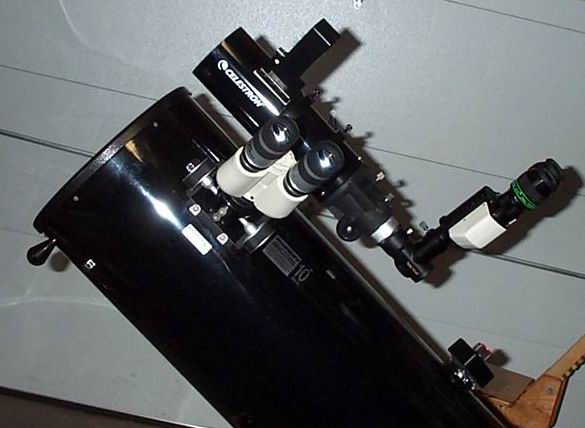
I became interested in binoviewers after a fellow XT10 owner mentioned that he had purchased a pair and was thoroughly impressed. I picked up a pair of Denkmeier standard binoviewers with a 1.25″ OCS and was hooked. I have since added a pair of Televue binovues with the 2x corrector and a 2″ Denkmeier OCS. I rarely look at anything with one eye anymore. The comfort that two-eyed viewing provides is worth the cost of the binoviewers and extra eyepieces. The view of the Moon is indescribable. This is the future of visual astronomy. Also, the Cloudy Nights Binoviewer forum is excellent.
Here are the 2 page instructions that came with my Televue Binovues.
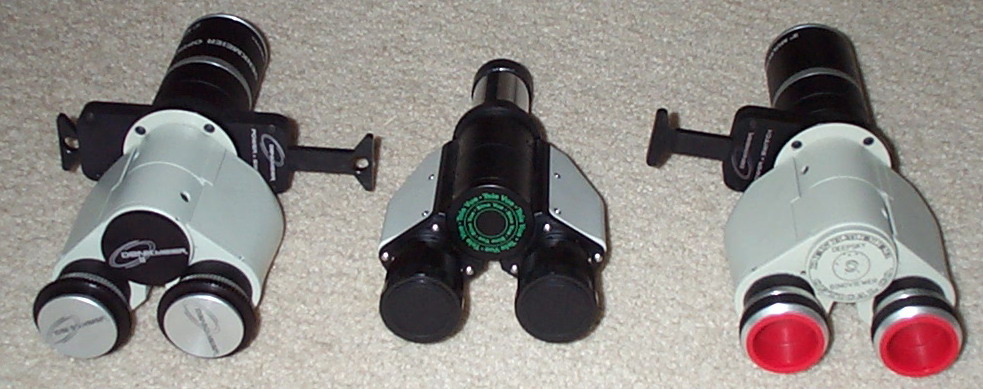
Here are my 3 current binoviewers. The one on the left is the Denk II’s with dual diopter adjusters and a 2 arm Power X Switch. The one in the middle is the Televue binovue with 2x corrector. The one on the right is the Denk Stds with a 2″ single arm Power X.
Time for some random Binoviewer thoughts (the Denk II’s are here)
I received my Denk II’s last Fri (Apr 30 2004). I had asked Russ about getting a pair a while back and he called me up and said my name was up on the list, did I want a pair? Well, sure, why not? I got the full meal deal: Denk II’s, dual SCD’s, Dual Arm 2″ Power X Switch. They arrived and brought a weekend of rain with them.
First impressions when I opened them was yup, look like Denks. I have the Denk Stds so I knew what to expect. The SCD’s were confusing at first. If you read the directions, they aren’t confusing. I don’t read directions, so I needed a couple minutes of futzing around to figure out which was the focusing part and which was the tightener part. I slapped in my 24 Pans to see if there was still the wiggly ep problem that my Denk stds have always had. They would wiggle if you tried hard enough, but not too much. Tonight is supposed to be clear, so we’ll see how they work out.
Looking into the ep holes with no extraneous pieces parts attached revealed a pink hue in the right and a blue hue in the left. Smart people figured out this is ok, so I accepted it for now.
The Power X Switch is neato keen. I was wondering how it would work in person. The machining is very precise. The optics do not move at all when the arm is seated. Zip, none, notta. That is impressive. Not sure misaligned or non-repeatable positioning of the upper elements would be a good thing.
It cleared up for about 5 minutes on Sat and I had a quick peek at Sol. I had just enough time to get focused and try out the power x a few times. I was very happy when the I could focus with the 24 Pans with 1/4″ room to spare. That’s actually 1/8″ more than I had with the regular 2″ OCS. I switched between the 3 powers and all I had to do was refocus. Now that’s what I’ve been waiting for in binoviewing. No more OCS pieces parts swapping to get to different powers. No optical evaluation was conducted as the clouds rolled in and I was too giddy to care at that point. Very cool stuff.
I set up my yardstick on the speed limit sign across the road about 100 yds away and set up for some magnification comparisons. Here’s what I found with my 11″ Starmaster EL, f/5.6:
Low power mode: 1.38x
Mid power mode: 2.1x
High power mode: 2.5x
Just as expected. Not sure how useful the 2.1x mode will be, but why not, gotta have all the bells and whistles.
It was partly cloudy Mon night, so I got to have my first “dark” with the Denk II’s. I also had the TV Binovues rigged up with a 2″ OCS single arm Power X. Time for a showdown.
Luna was up and full. That would be my first target. Had the 24 Pans in and low power selected on the Power X. Centered up Luna and had my first look. WHHOOAAA!!!! What’s all that color? Pink on the right side and blue/green on the left. Geesh, ooowww, oohhh, eeeeaaahhhh. I swapped eyes (actually, I just looked through the right side with my left eye) and holy crap! it’s even worse. This is dreadful. I focused on the moon and alternated closing an eye and checking out the pretty pink/blue moon. Something must be wrong.
I went inside and emailed Russ and a few other folks that I know who own Denk II’s to ask about this. Got a reply back from Russ at 9:00 at night (whatsup with dat? 😉 and he explained about the transmission and reflectance of the beam splitter and coating and asked me to go back out and see how much color there was with both eyes merged and settled in. I did that and things were much better. When I first put my eyes up to look at the moon, I see the separate pink and green until the image merges. Then I just see a white moon. Very strange, but it worked. If I closed one eye, the moon would take on the color of that side of the binoviewer (pink=right blue=left). But open both eyes and it turned white. The mind is a wonderful thing.
I decided it was time to see what the TV’s did. There was no color difference at all that I could see, but the image color looked the same as when the Denk II’s were merged. I tried the Denk Stds and noticed a slight brightness difference and maybe a slight blue tint to the left side. But again, merge the images and all white.
I haven’t made up my mind on this issue yet, but I’m going to take many, many nights viewing all manner of objects to see how I like it.
Ok, in the meantime, I talked to Russ and he mentioned a lower power lower element (part S) that might work for me and my Starmaster. It arrived today (Tues) and I immediately installed it on my dual arm power X. Sol was out so I put the filter on and had a look. Hmmm, not enough back focus. I extended the OCS all the way and just barely missed focus. I had about 3/16″ left on the collimation bolts, so I moved the primary up 1/8″ and just got the 24 Pans to focus. 1.2x is much mo better than 1.4x. Granted, the OCS was now sticking into my light path a full 3/4″, but I didn’t care so much. It only does that at low power and I challenge anyone to notice the effects of an OCS sticking 3/4″ into the light path at 78x. I went from 88x to 78x and from .74 deg TFOV to .84 deg TFOV. That extra .1 deg TFOV may not sound like much, but it made Sol oh so much nicer.
Now for the kicker. When you go to the mid or high power setting, it requires you to rack the focuser out to the point where the OCS is no longer sticking in the light path. So, you don’t get that OCS mucking up your high power views when you are trying to track down that elusive rille in the Alpine Valley.
I measured the mags on the low power OCS and found the following:
Low power mode: 1.2x
Mid power mode: 1.7x
High power mode: 2.1x
I also took a look at whether I had any room to move the primary up in the Starmaster. I put my eye over the focuser where I thought the focal point was and looked into the focuser at the secondary. I could see a little border around the primary. I interpreted that as having a little room to move the primary up and still not vignette the light cone at the secondary. The Starmaster design is elegantly simple and moving the whole mirror cell up took 10 minutes. I just moved the 4 corner blocks up 1/2″ and then re-installed the primary cell. Easy peasy. Put the magnificent ZOC primary back in, collimated with my wonderful Catseye tools and I’m ready to go. I checked if I could still see the entire primary by looking in the focuser and oila, I could. It just fit perfectly in the secondary. That means that I got an extra 1/2″ for free. Tonight is supposed to be clear and steady.
The benefit of moving the primary up is that I can shorten the OCS up by the same amount and it won’t stick out so darn far. Not that it effects the view, it just looks darn goofy. This was such a quick and easy and penalty free (at least I think it is) mod, and I get a very low power corrector system out of it. The one I always wanted but never got.
All this was possible because I had mentioned that lower power would sure be nice. I had not heard mention (at least not that registered in my brain housing group) of Russ having a lower power option for the Newt OCS. It does require about 3/4″ more backfocus, but I found that by moving up the primary and extending the OCS 1/4″.
The penalty I paid for moving the primary forward was the balance shifted. I was only using 3 speaker magnets to balance the scope. Now I need 6. I thought I had gotten off scott free, but viewing the moon low in the sky tonight proved otherwise.
Another thing I found was that the older 2″ OCS’s have a slightly different hollow nose piece than the newer ones. The new ones have a dual thread system that Russ said they designed to make it easier to re-configure the OCS. That was before the Power X was around. It does help when you have to re-configure, but it does take away about 3/16″ of available extension. This could mean the difference between focusing and not. I used my older 2″ OCS initially to get the extra length, but now that I have the primary moved up, I will swap back to the new one. That old stuff is, well, old. Gotta go with the shiny new stuff.
No impressions yet on the viewing performance other than the aforementioned color fiasco. The seeing and clouds have prevented any good viewing. Hopefully tonight will be better and I can get some good comparisons in.
UPDATE, Tues night (4 May 2004)
It’s clear, the moon is full and the seeing is below average, but it’s a lot of fun. The moon’s not out yet, but all the neighbor’s porch lights are on. So, I had a peek at Jupiter to use the SCD’s and compare to the TV Binovues.
I quickly learned via the SCD’s that I do indeed have a difference between my eyes. I get tested annually for my flight physical and I knew there was a difference, but never really noticed anything while binoviewing. Never really looked for it either. I am 20/10 in my left eye and 20/15 in my right for far vision. For near vision, I’m getting old and I’m 20/25 in my left eye and 20/30 in my right. Not enough to warrant a different prescription in each eye for reading glasses. But, as it turns out, enough of a difference to require the use of the SCD’s.
The best way I found to focus for Jupiter was to use the moons. I played with the focuser until I found exactly where in focus was for the right eye. Then I looked through just my left eye to see if it was in focus. Hmmm, a little different. I then just focused my left eye and used the SCD on the right to get that one dialed in. So, how much difference was there? Well, I had the left SCD opened up 1/16 turn. I had the right one opened up 3/8 turn. That made both eyes focus at the same time. I tried this several times and each time came up with the same difference.
Maybe this was due to a difference in the path lengths between the sides of the Denk II’s. Easy to verify, I guess. I put the TV Binovues in that I have been using for a year without adjusting between the sides (pulling out an ep to focus it). I focused my right eye and looked through my left. Sure enough, there was a slight difference in the focus point. I’m sure it’s always been there and my brain took care of it, but I didn’t really nail it down until now.
Does it matter? Dunno for sure. Seeing isn’t good enough right now to get a definitive answer. First impression, which is the one I always trust, the image of Jupiter snaps into focus more crisply with the SCD’s than without. If I leave the SCD’s bottomed out to simulate the same mismatch as the Binovues, the image loses the crisp snap and resembles the Binovue focus. It will take better seeing to determine if there is a difference in the fine detail visible with and without SCD compensation.
I can say that one SCD would have been plenty for me. A fixed left with an SCD right would have worked just fine. I did not know that before, now I do. Now, I just leave the left bottomed out and after the ep’s are in, I turn the right one 1/4 + skosh turn to match the sides. So, the SCD’s are keepers.
The Views
Well, the seeing is pretty good, 4-5 on the Pickering scale, and I did a comparison between the Denk II’s and TV’s. I was using the Denk II’s with the 2 arm, low power OCS in high power mode for 2.1x and the TV’s had the 1 arm regular power OCS in 2.5x mode. I used 18mm UO orthos in the TV for 212x and 15mm Pans in the Denk II’s for 215x. I also used the 15 Pans in the TV’s for 255x and the 13 Naglers in the Denk II’s for 248x. The views were better in both binoviewers with the lower power (212x and 215x) so I did most of my comparison there.
I think the SCD’s on the Denk II’s won the day here. The details were about the same between the two, but the fine details were more often seen and easier to see in the Denk II’s. It’s hard to explain, but I felt I could see more details, more easily in the Denk II’s. I tried to adjust the ep’s in the TV’s so I got an accurate focus between the two sides, but the accuracy of positiong was just not there as it was with the SCD’s. I should wait until I get a night of great seeing to be sure, but I don’t know that that is necessary at this point. The SCD feature has me sold on the Denk II’s.
I also did a comparison of the 1.66x mode of the dual arm Power X and much to my surprise, it was very good. I am going to keep the Denk II’s and sell the TV’s and Denk stds, so I will have more time to compare the mid power mode in the future. Ah, who am I kindding, I’m going to head out right now and check it out. More to follow…
I did a quick comparison of the 13 Naglers at mid power mode (195x) and the 15 Pans at high power mode (215x) and noticed no difference. It will take a good night of seeing to make a definitive determination.
I did some more investigation on the color issue. There is definitely a slight off color hue to the moon in the Denk II’s in low power mode with the 24 Pans. It is subtle compared to the Denk stds and TV Binovues, but it is definitely there. On Jupiter, it is not noticeable with both eyes. No color on stars. So, I will live with it because the benefits of the Denk II far outweigh this.
I played around a lot with the SCD’s and have decided the left will stay locked down all the way. The right consistently required a skosh over 3/8 turn to match the left. IMHO, this feature should be on all binoviewers. It is the biggest factor for why I am keeping the Denk II’s. The shorter path length, which allows me to use the 1.2x OCS is the other. Although I haven’t done a rigorous comparison of the views on deep sky. I don’t plan to, either. I know the Denk II’s are no worse than the TV’s on Jupiter and that’s good enough to divest in the other 2 binoviewers.
I also compared the Denk stds with the 1.4x OCS and 24 Pans to the Denk II’s with the 1.2x OCS and 24 Pans. I was looking at the moon to see if that extra .1 deg TFOV really mattered. It was noticable and framed the moon more easily, but it wasn’t a big deal. It made a wonderful improvement with the sun. So, not a big deal, but it was practically a no brainer to go with the 1.2x OCS.
CONCLUSION
Keeping the Denk II’s and the 2 arm low power OCS. Selling the Denk stds and TV binovues. That pretty much says it all.
TELEVUE BINOVUES WITH DENK 2″ OCS
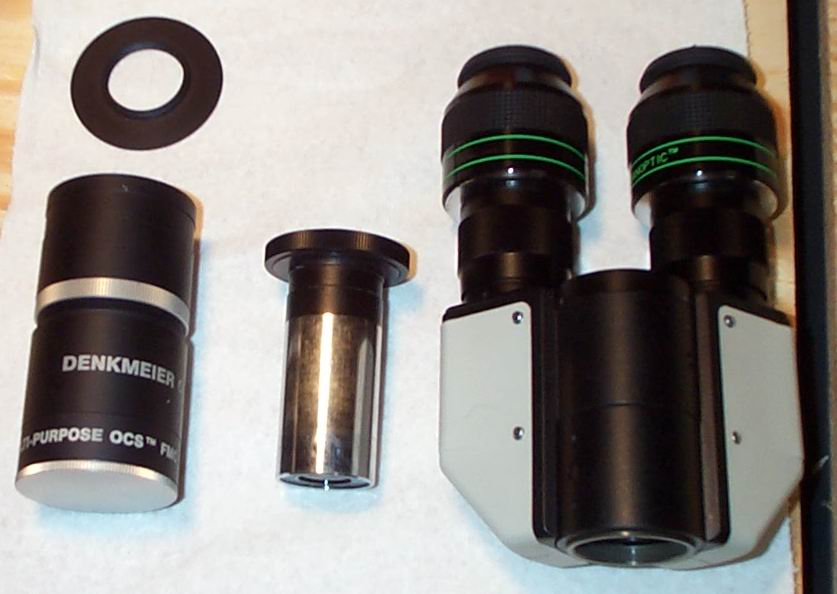
This is a picture of all the pieces parts. The ring in the upper left is the low profile adaptor that Denk makes that allows the Denk 2″ OCS to be used on the Televue Binovues without adding a lot of path length. The Denkmeier 2″ OCS is the large tube on the left. The TV 2x corrector with the entire nose piece attached is in the middle. The TV binovues with nothing on the nose is on the right. Those are 24 Pans.

This shows the Denk adaptor attached to the TV binovues.
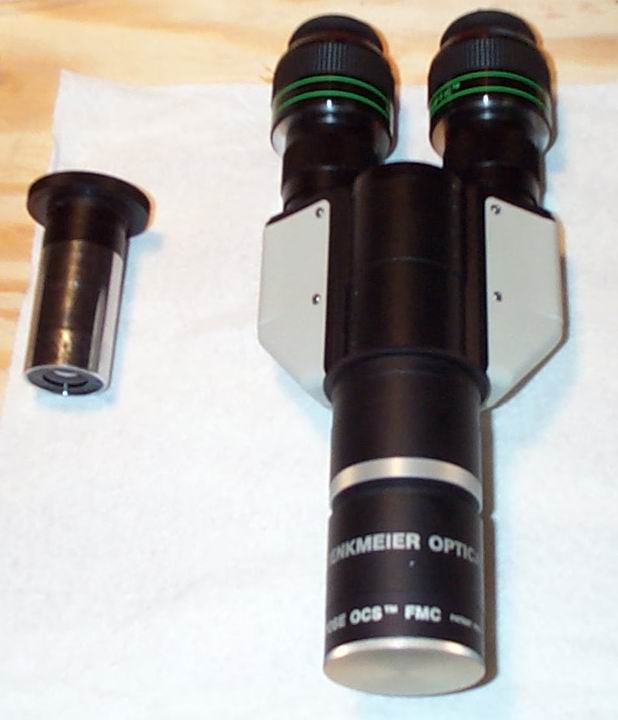
Here’s the 2″ OCS on the binovues. To swap the OCS for the 2x corrector, you have to remove the 2″ OCS WITH the adaptor. Then you simply screw the 2x corrector with it’s nose piece on the binovues.
A word of interest. The nosepiece on the TV binovues is a 3 piece T adaptor type setup. I remove all 3 pieces with the corrector as one unit. If you don’t do this carefully, you will only unscrew one part of the nose piece, leaving a ring and T adaptor in the binovues. The 2″ OCS will not screw into this.
Removing the eyecups from Pentax XL’s
I recently re-acquired a pair of Pentax 10.5mm XL’s to try with my binoviewers. I found out that I had a compatible IPD (interpupliary distance) but the eyecups did not allow enough room for my nose. So, I removed them. Didn’t know you could do that, but it turns out you can. Here’s how:
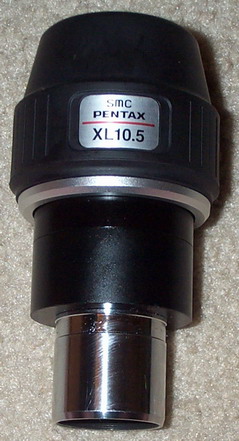
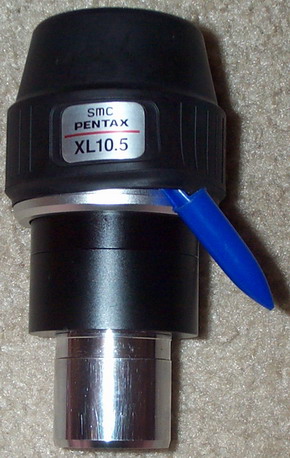
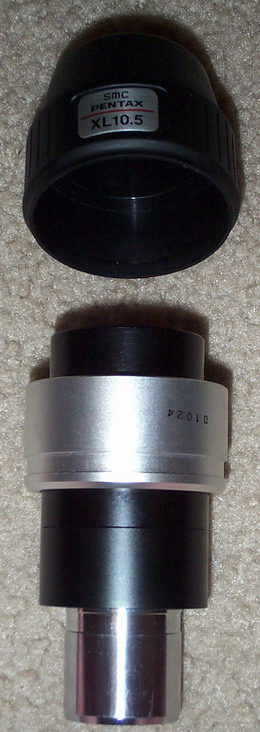


Works like a champ.
Binoviewer Clear Aperture
Here’s a binoviewer clear aperture effects calculator I put together. The assumptions are listed in it. The % illumination at 27mm is based on the Newtonian Claculator. I just adjusted the size of the secondary at various focal ratios so that the 100% illuminated field size matched that from the binoviewer clear aperture spreadsheet. Then I just looked at what the % illumination was at 27mm, made a scatter plot and developed an equation to calculate the % illumination at 27mm. The equations get a bit non-linear when the illuminated field gets above 20mm or so, but I just left it as a linear approximation. So, if you have a large clear aperture bino in a slow scope that yields a larger 100% illuminated field, my 27mm illumination numbers will be off. But, who cares. You’re already close to full illumination and we’re talking a difference of 3%. Not enough to get yer undies in a bunch.
I just finished reading this article that was just published on Astromart:
http://www.astromart.com/articles/article.asp?article_id=30
Thought I’d go see how it applies to binoviewers.
I put the Denk II’s in with the low power dual arm power switch. Should give me 1.23/1.67/2.11x magnification. I know my Starmaster’s focal length is 1527mm and the mirror is 279.4 mm in diameter. I have accurately measured the mag of the power switch. I’ll trust that TV makes ep’s that match their advertised focal lengths. So, I went out and measured some exit pupils;
Eyepiece (mag factor): measured exit pupil (predicted exit pupil)
35 Pan (1x): 6.5 mm (6.41 mm)
24 Pan (1x): 4.5 mm (4.39 mm)
In the Denk II’s w/ Power Switch
24 Pans (1.23x): 3.6 mm (3.57 mm)
24 Pans (1.67x): 2.5 mm (2.63 mm)
24 Pans (2.11x): 2.1 mm (2.08 mm)
13 Nags (1.23x): 2.0 mm (1.93 mm)
I’d say the ruler in front of the ep method is accurate to +- .1 mm.
Conclusion: There definitely is no physical vignetting of the light cone on axis.
So, where does it start vignetting? Well that was a little harder to nail down. Per the article, I slowly moved my eye to one side while watching the exit pupil. As advertised, it became elliptical as you moved off axis. At one point, I could see that the side of the ellipse towards the center of the ep was being cut off by something. I verified this in all directions. The point at which this happened was repeatable and measurable (well, kindof).
The only thing that I could kindof measure was the distance from the center of the ep to the center of the exit pupil at the time the vignetting occurred. I don’t know what this measurement means as Rick did not explain it in his article. Maybe it was pure coincidence that this distance was the same in both the 24 Pans and 13 Naglers (8-9 mm) and that this distance also happens to match the predicted 100% illuminated field size for this setup (9.4 mm).
I went ahead and put the 10.5 mm Pentax XL’s in and they started to vignette just prior to hitting the field stop (maybe 2mm prior). That matches as well as the 100% field is still 9.4 mm and the 10.5 XL field stop is 11.4mm.
So, all of this matched up. If you wanna see if/where your binoviewers are vignetting, this’ll do it. Measure the exit pupil diameter and see if that matches with predictions. If it does, the binoviewer is not cutting off the light cone at the center. Then slide that exit pupil out and see when the inside starts clipping. This takes some practice to get used to seeing it. It’s not obvious at first. Measure how far out from center this happens (this is harder to be accurate) and compare that to theory. Mine seems to match right on for my Denks II’s and power switch.
I am happier now that theory and observations have sorta matched up. Of course, I acknowledge that I could be dorked up and have it all wrong.
Here’s a comparison of images from my 3 binoviewers:
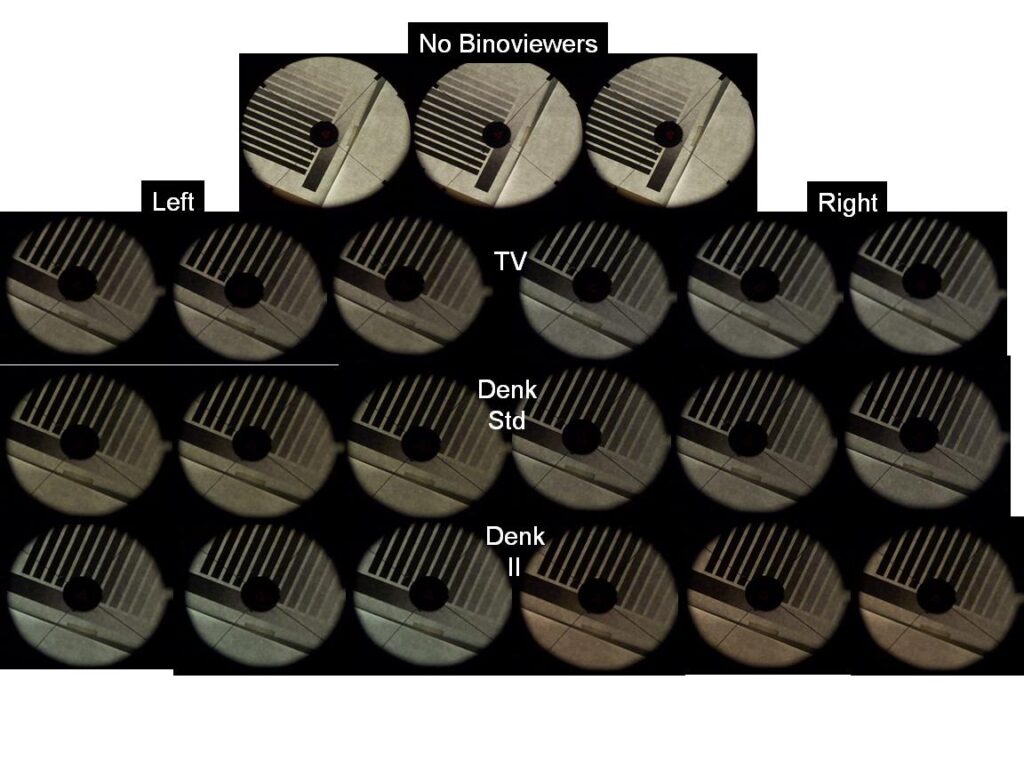
Here’s the Powerpoint file (1.4 mb) that has all the individual images if you want to rearrange them to taste.
I merged the images in Photoshop and made the right one 50% transparent. This is to simulate what might be happening when the brain merges the two sides of the binoviewer:

Not sure if I can conclude anything other than the merged images do look different than the separate ones.
LIGHT SHIELD
I made this one night when the neighbors had all their porch lights on. Wait, who am I kidding, that happens pretty much every night.
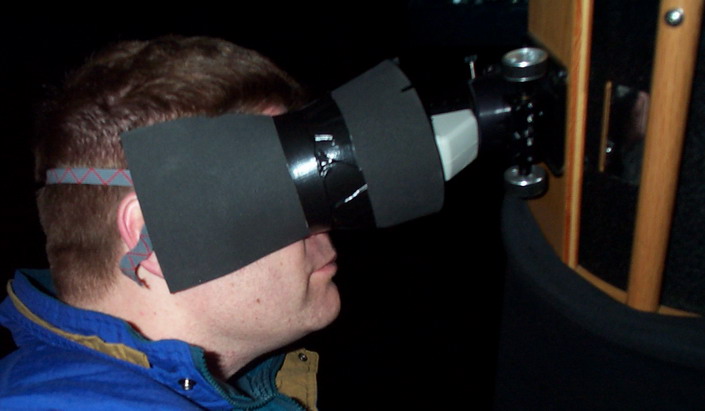

Just a basic pair of safety goggles with the plastic removed. The stuff around the outside is 3/16″ foam rubber from Michaels craft store. This works really well with both the binoviewers and binoculars. I tried shrouds that I draped over my head, but they always fogged up the ep’s. Since my nose is outside this light shroud, nothing gets fogged up. I do scare the bejesus out of the kids when I come in the house with them on.
Give ’em a try.
